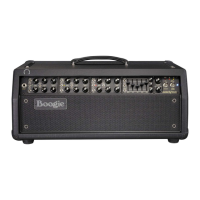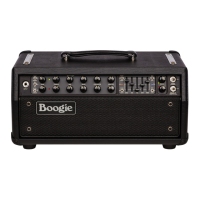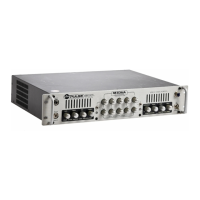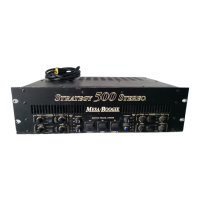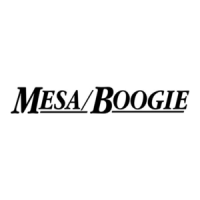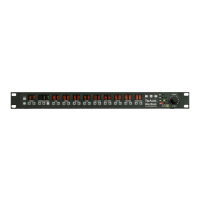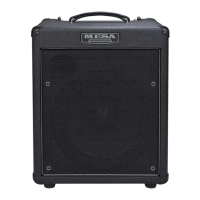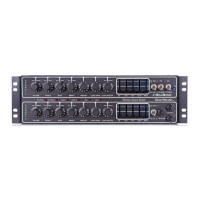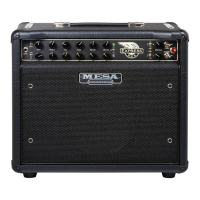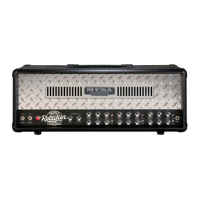PAGE 21
As mentioned earlier in the Helpful Hints Section, as the GAIN control goes up, the BASS control should usu-
ally come down. This will ensure a definitive attack and a balanced dynamic response. This is most especially
true in Channel 3’s Modes for the best attack characteristics as excess low end dialed up early in the preamp
can cause flub and indistinct attack characteristics. We’d suggest keeping the BASS control below 11:00 for
medium to low gain sounds and lower for high gain sounds, possibly even as low as 9:00 or even occasionally
o for the highest gain applications.
For lower to mid-gain sounds such as in blues, R&B, roots, and country in Channel 3, you can set the BASS a
little higher than 11:00 to add girth and breath to the sounds. However, if you are running the GAIN control much
past 12:30, you will discover the attack can be compromised pretty quickly by this up-front low-end available
on the BASS control.
Clean sounds can more easily support higher BASS settings than overdrive sounds. Most players find a nice
balance between 11:00 and 1:30 depending on the application, GAIN setting, and the instrument’s scale length,
wood, and pickups. However, if you are using CLEAN or FAT for clipped sounds with the GAIN control maxed
or nearly so, you will be better served with the BASS set as low as you would with overdrive sounds in the
higher gain Modes.
If you need a lot of low-end combined with high gain sounds for hard rock, metal, or heavy prog sounds, we
suggest looking toward the Graphic EQ’s two lowest Bands (80 Hz and 240 Hz) for the best performance.
The Five Band Graphic EQ comes at the very end of the preamp’s signal path and right before the power sec-
tion, so low end dialed up there is not further amplified in the preamp. In contrast, the BASS control is located
upstream early in the preamp’s signal path, and low frequencies added there are subject to more amplification
and can quickly become overbearing and swamp the attack, especially on high gain sounds, sounding imbal-
anced and tubby/flabby.
Just keep in mind that the two lowest Bands of the Graphic EQ, when coupled with high BASS settings and
especially high GAIN settings, can also overwhelm the attack and swamp the sound. Again, use common sense
and taste to achieve the best blend of low-end and attack clarity.
High settings of either, and especially both combined, can also have the potential to create unwanted vibrational
noises in a Combo and, at extreme volumes, can even have the potential to cause possible speaker damage.
Use common sense and taste to ensure uninterrupted performance.
THE FIVE BAND GRAPHIC EQ WINDOW
A Boogie hallmark since the early 1970s, the Five Band Graphic EQ is famous for its precision shaping power
and the versatility upgrade it brings to our Boogie amplifiers, both big and small. It allows surgical level control
of the frequency spectrum and yet, at the same time, is broad and sweeping enough to be fast and easy to dial.
Another attribute is that its placement at the end of the preamp’s signal path is perfect for enhancing high-gain
sounds. This late placement in the circuit allows far more low end to be added than would otherwise be possible
farther upstream in the preamp, where it would be further amplified through the signal path and subsequent
tube stages.
The five frequency bands are “broad Q” and range in center frequency point from 80 Hz on the low end to 6600
kHz on the top end, with 750 Hz commanding the all-important midrange in the center. Each band provides
approximately 12db of cut and boost from the center line’s “Flat” detent point, and that provides ample room
to radically shape the sound or just subtly enhance it.
The most classic application for the Graphic EQ in MARK amplifiers is the time-honored and widely used dipping
or “scooping” of the 750 Hz Mid Band in conjunction with the boosting of all the other Bands in a “V” pattern.
This creates a wide, 3-D spread and delivers huge Crunch Rhythm performance from, obviously, the CRUNCH
Mode found in Channels 1 and 2, the MARK VII Mode in Channel 2, and the IIC and IV Modes in Channel 3.
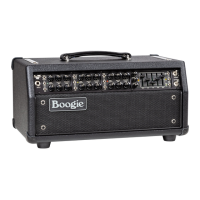
